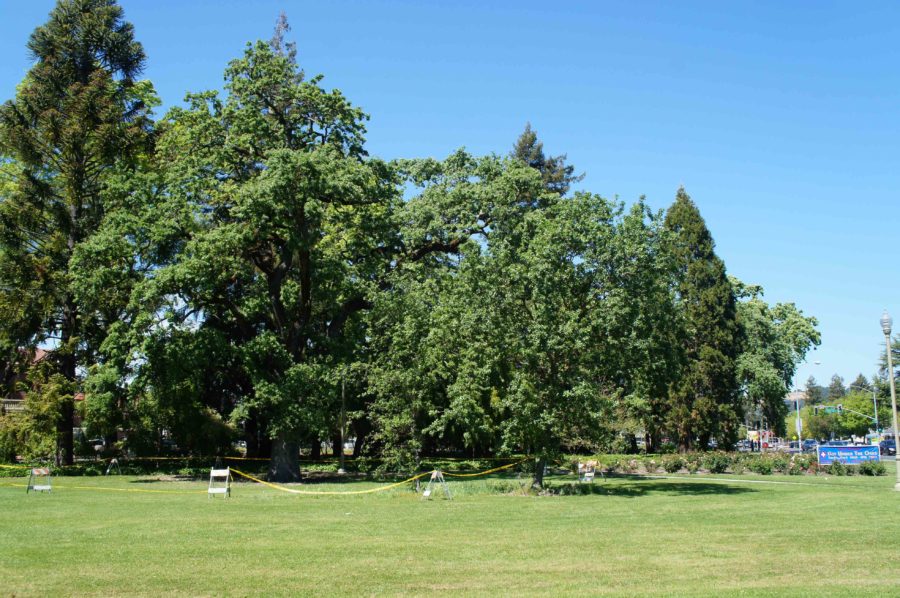If an oak tree falls on campus, it does make a sound.
A total of six oak trees have fallen or been felled in the past year at Santa Rosa Junior College.
The first tree was a 250-year-old, 15-ton oak tree that stood behind the main “Santa Rosa Junior College” sign in the open field at the front of campus. The oak fell Nov. 21 during a severe windstorm. The second fell Feb. 8 near the Hyde Park garden near the stage where SRJC holds graduations.
On April 18 and 19 SRJC grounds crew and private contractors removed four more oak trees. Three of the trees were also near the graduation platform and the fourth was on the front lawn.
The felled trees were infected with disease and riddled with fungi that made them a safety risk to students and faculty. SRJC President Dr. Frank Chong said a “tree doctor” comes annually, and was at SRJC on April 24.
One such diseased tree that was removed is the large oak on Burbank Circle. It contracted a so-called “oak root fungus” endemic to Californian soil. It had less than half its healthy life left, according to Bill Pramuk, consulting arborist with Tree and Garden Vitality. There was healthy root tissue around 40 percent of the base of the tree, Pramuk added. Affected trees can sometimes recover from these fungi, but it depends on age.
“A lifespan of a tree is like the lifespan of a person or any living thing – as they get into old age, they’re less resistant to disease; [they] heal slower,” said Carl Dobson, manager of grounds and recycling at SRJC.
Dobson said the vast majority of trees on campus are healthy and strong. The diseases they contract, however, pose a significant risk of trees falling and causing damage. Dobson said that much like cancer, these fungi could spread over time and deteriorate their hosts until the tree poses a safety hazard.
“We try to stop it before it gets to that point,” Dobson said. The only way to stop a sick tree from getting worse is to cut it down.
“It’s a sad thing having to remove a tree. I hate doing that. They add so much to the campus. They’re one of the first things people see,” Dobson said.
The faculty has long supported trees on campus; Bertolini Hall was even restructured to accommodate the trees, as was the sidewalk along Elliott Avenue.
The trees of SRJC are still more likely to experience problems. Oak roots run wide and deep, and can span up to 70 yards, three times the length of the tree’s long branches. These roots run under streets and buildings and experience heavy foot traffic every day, making them more susceptible to stress.
“Roots don’t like compacted soil,” Dobson said. This pressure on the roots only compounds the trees’ health concerns.
“We did get some suggestions from people, like the Press Democrat wrote, ‘the reason your oaks are dying is because you have a lawn there, and you water the lawn, and the trees really don’t like water,’” Chong said. “So we’re going to respond to that and make less lawn and have bigger dirt circles around the oaks so that they don’t get as much water.”
SRJC tree maintenance man Robert Carretero has also seen his fair share of fallen and diseased trees, and says that his biggest concern is safety.
“We try to keep the trees safe,” Carretero said. “Safety trumps everything else.”
Anecdotes aside, the name of the game is safety, and keeping trees healthy and safe for others is what the grounds crew does best.
When asked if it was hard to take care of a 200-year-old tree that just keeps growing after you leave, Dobson said, “We just kinda help them on for a while, then pass it on.”
According to Dr. Chong, new oaks will be planted. “We look for spots where we think they’ll do well,” he said. He says they plan on planting one for every one that has fallen.
“We’re gonna make tables and benches out of the wood,” Dr. Chong said. “But they have to be treated; it takes like two to three years before they become dried out enough to work.”
The cut-down trees are currently in a fenced-off lot on Elliott Avenue.
- October 18Thousands gather all across North Bay for second day of No Kings protests
- October 8Protesters gather to support, oppose trans athlete at SRJC volleyball match
- October 2SRJC dance coordinator absent from classes while critics and supporters continue to speak out
- September 14SRJC community rallies in support of trans volleyball player
- September 10SRJC, women’s volleyball coach and 3C2A under fire for alleged Title IX violations



Ellen Olah • May 2, 2014 at 12:05 am
I have a question. If the roots stretch about seventy feet from the trunk, and the lawn is watered within those seventy feet (assuming the larger dirt circle does not span a full seventy feet), wouldn’t the water still infiltrate into the ground pooling around the roots causing the fungi to grow? Couldn’t we replace the lawns containing the oaks with native bush grasses and drought tolerant vegetation? We would be using less water and aid in the prevention of other tree hazards due to fungal growth. There are many beautiful native perennial plants that work well with oaks and native grasses. I’m just wondering, is there something I’m missing?